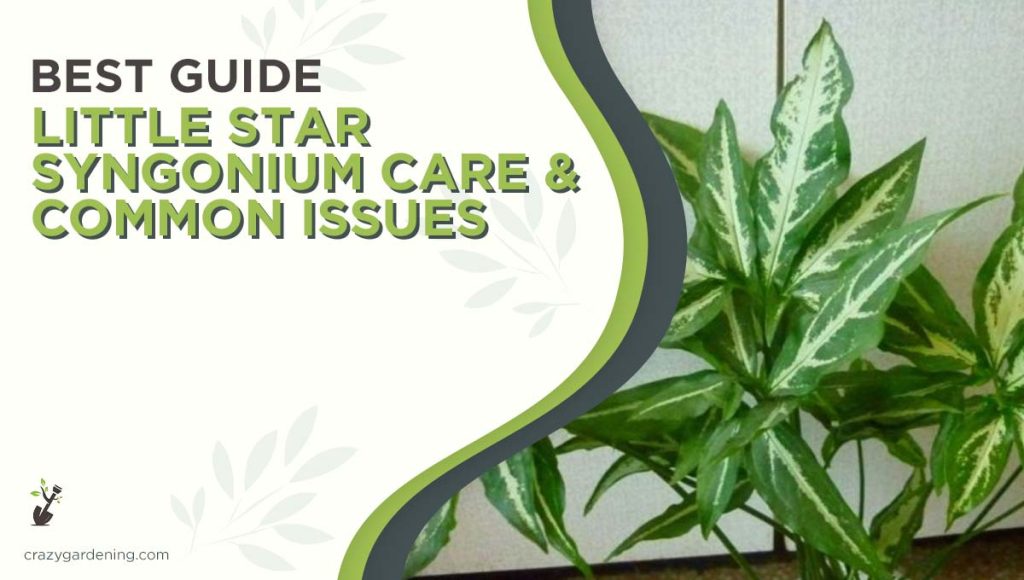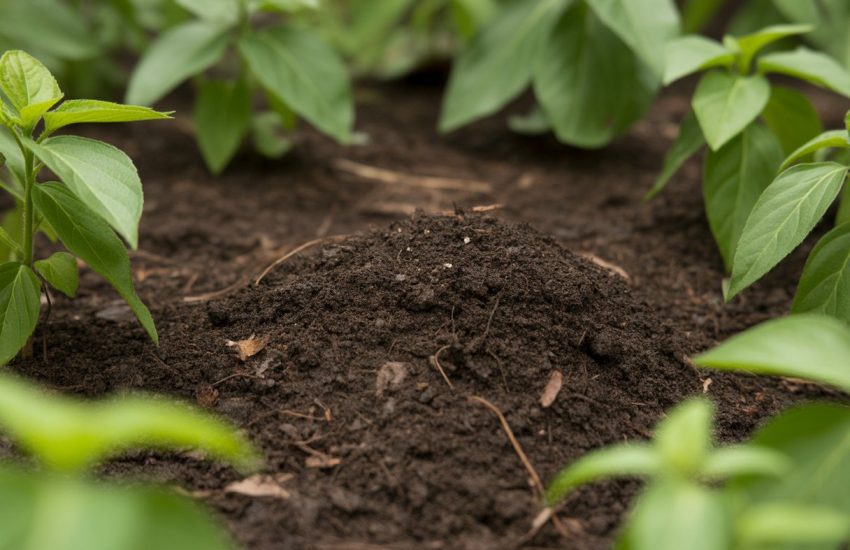Little Star Syngonium Care & Common Issues [Best 2025 Guide]
If you’re like me, there’s nothing quite as satisfying as taking care of a houseplant and watching it thrive. And if you’re new to keeping plants indoors, the little star Syngonium is a great place to start.
This easy-to-care-for plant can adapt to a range of light conditions, making it perfect for both sunny and shady spots in your home.
In this blog post, I’ll share some tips on how to care for your little star Syngonium so that it can grow big and strong. Happy gardening!

What is Little Star Syngonium?
**Family**: Araceae
**Common Names**: Arrowhead Plant, Arrowhead Vine, Goosefoot
**Botanical Name**: Syngonium podophyllum
The little star Syngonium is a tropical evergreen vine that is native to Central and South America.
Arrowhead vines may appear to be cute, well-behaved houseplants at first, but as their name suggests, they eventually become sprawling, multi-trunk monsters.
Some, like the allusion series, tend to remain relatively close together, while others, like the White Butterfly, open their wings and soar in every direction!
These vigorous spreaders respond well to trimming and will produce fuller plants if you take the time to do so. As long as you don’t forget to water them, Syngonium is a low-maintenance plant.
The low light tolerance of these houseplants means you can put them in almost any place. Their leaves come in a rainbow of hues and patterns; pick the one that best expresses who you are.
Little Star Syngonium Care Guide
Light Requirements
The little star Syngonium will do well in a range of light conditions, from low light to bright, indirect light. If the leaves start to turn yellow or pale, that’s a sign that the plant is getting too much sun.
The leaves will shrivel up and die in the hot sun. When placed outside for the summer, arrowhead vines can thrive in the early morning sun, but the hot afternoon sun will burn the leaves.
If natural light is an issue where you live, you can also cultivate syngoniums using artificial lighting. Because they are cool to the touch and consume very little power, LED growth lights are ideal.
Water Requirements
Arrowhead plants like to be kept moist but not soggy. Water your plant when the top inch of soil feels dry to the touch.
If you’re not sure whether your plant needs water, it’s better to err on the side of caution and give it a drink. These plants are very sensitive to drought and will start to drop leaves if they are too dry.
To avoid over-watering, make sure the pot has drainage holes and that you’re using a well-draining potting mix. I like to use a mixture of peat moss, perlite, and vermiculite.
Humidity Requirements
These houseplants may survive in the typical 40-50% humidity found in most homes, but most will thrive in humidity levels over 60%.
You may enhance the humidity surrounding your arrowhead vines in a few different ways; choose the method that works best for you and your garden’s appearance.
Fertilizer Requirements
Fertilize your little star Syngonium every two weeks during the growing season (spring and summer) with a balanced, water-soluble fertilizer.
You can dilute the fertilizer to half-strength to avoid burning the roots.
Syngoniums are not heavy feeders, so you don’t need to fertilize them more than once every two weeks. If you do fertilize more often than that, leach the excess fertilizer from the potting mix with a few waterings.
Syngoniums are light feeders and will do well with a half-strength application of a balanced, water-soluble fertilizer every two weeks during the growing season.
Pruning Requirements
Arrowhead vines can grow quite large, so you’ll need to prune them regularly to keep them under control. You can prune them back hard if necessary, and they will quickly bounce back.
To encourage bushier growth, cut the stems back to two or three leaves. You can also pinch the tips of the stems to promote branching.
Temperature
Arrowhead Vines may thrive in the typical range of 6080 degrees Fahrenheit found in most homes.
Colder than 50 degrees Fahrenheit is too cold for them. In the colder months, make sure they aren’t near any windows or doors.
Propagation
Arrowhead vines are very easy to propagate. The easiest way to do it is by taking stem cuttings in the spring or summer.
* To take a cutting, use a sharp knife or pair of scissors to cut a 4-inch piece off a healthy stem. Make sure the cutting has at least two leaves.
* Remove the bottom leaves and dip the cut end in the rooting hormone.
* Fill a small pot with a well-draining potting mix and plant the cutting about an inch deep. Water it well and place it in a warm, humid spot out of direct sunlight.
* The cutting should root within two to four weeks. Once it has rooted, you can transplant it into a larger pot.
Related Articles
* Piper Ornatum Care
* ](https://plantnative.org/gardening/philodendron-dark-lord-vs-black-cardinal/)[Anthurium Villenaorum Care
* Dischidia Ovata Care
* Anthurium Wendlingeri Care
* Anthurium Pedatoradiatum Care
Common Issues with Little Star Syngonium
There are many problems that can be done with your Little Star Syngonium and you have to protect it from them.
Diseases
The most common disease that your plant will suffer from is Leaf Spot. This occurs when the leaves of your plant are damaged and start to turn brown or black.
The spots can be any size, but they’re usually small. To prevent this disease, make sure you water your plant at the base so the water doesn’t splash on the leaves.
You should also remove any damaged leaves as soon as you see them. If the disease is severe, you can treat it with a fungicide.
Drooping leaves
If the leaves start to droop, that’s a sign that the plant is too dry. Water it and see if that helps.
Yellow leaves
If the leaves turn yellow, that’s a sign that the plant is getting too much sun. Move it to a shadier spot. Inadequate or excessive fertilization are two other possible causes of yellowing leaves.
When plants receive excess fertilizer, it can damage their roots and cause their leaves to turn yellow. Iron and nitrogen deficits, which can result from not applying enough fertilizer, cause leaves to turn yellow.
Pale leaves
If the leaves turn pale, that’s a sign that the plant is getting too much sun. Move it to a shadier spot.
Pests
Common pests include mealybugs, aphids, spider mites, thrips, whitefly, and scales.
Keep the plant’s leaves clean and dust-free, and check it for insect damage on a regular basis to identify problems before they escalate. Insects may be hiding in the axils or under the leaves.
Conclusion
As long as you give Little Star Syngoniums the circumstances they need to thrive, they require very little attention from their owners.
The soil should feel dry to the touch before you water the plants, and they should be exposed to bright, indirect light.
If you follow those steps, you will be rewarded with a robust plant that will continue to do well for many years to come. Thank you very much for reading!
FAQs
Question
How do I keep my Syngonium plant healthy?
Answer
Even though these plants may survive with very little light, they will develop more quickly and keep their vivid coloration and markings if they are cultivated in medium to bright indirect light for at least six hours each day.
Question
” How much sunlight does Syngonium need?”
Answer
When the top inch (2.5 cm) of your Syngonium plant becomes dry, you should water it. This occurs somewhere in the neighborhood once per week during the spring and summer months, but anywhere from once every ten to fourteen days throughout the fall and winter months.
Question
Does Syngonium need sunlight?
Answer
Yes, Syngonium plants require bright, indirect sunlight to thrive, but they can also grow in low-light conditions. Direct sunlight can burn their leaves.
Question
Where should Syngonium be placed in a home?
Answer
Syngonium plants should be placed in a bright, indirect light location in a home, such as near a window with filtered sunlight or under fluorescent lights.
Question
How do you take care of a mini Syngonium plant?
Answer
To care for a mini Syngonium plant, place it in a bright, indirect light location, water it when the top inch of soil is dry, and mist its leaves regularly to increase humidity.


